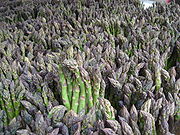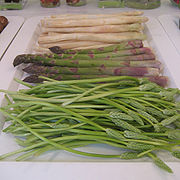
Asparagus
Did you know...
SOS Children produced this website for schools as well as this video website about Africa. Click here to find out about child sponsorship.
| Asparagus officinalis | |
|---|---|
 |
|
| Wild Asparagus in Austria | |
| Scientific classification | |
| Kingdom: | Plantae |
| Division: | Magnoliophyta |
| Class: | Liliopsida |
| Order: | Asparagales |
| Family: | Asparagaceae |
| Genus: | Asparagus |
| Species: | A. officinalis |
| Binomial name | |
| Asparagus officinalis L. |
|
| Nutritional value per 100 g (3.5 oz) | |
|---|---|
| Energy | 85 kJ (20 kcal) |
| Carbohydrates | 3.88 g |
| - Sugars | 1.88 g |
| - Dietary fibre | 2.1 g |
| Fat | 0.12 g |
| Protein | 2.20 g |
| Thiamine (vit. B1) | 0.143 mg (12%) |
| Riboflavin (vit. B2) | 0.141 mg (12%) |
| Niacin (vit. B3) | 0.978 mg (7%) |
| Pantothenic acid (B5) | 0.274 mg (5%) |
| Vitamin B6 | 0.091 mg (7%) |
| Folate (vit. B9) | 52 μg (13%) |
| Vitamin C | 5.6 mg (7%) |
| Calcium | 24 mg (2%) |
| Iron | 2.14 mg (16%) |
| Magnesium | 14 mg (4%) |
| Phosphorus | 52 mg (7%) |
| Potassium | 202 mg (4%) |
| Zinc | 0.54 mg (6%) |
| Manganese 0.158 mg | |
| Percentages are relative to US recommendations for adults. Source: USDA Nutrient Database |
|
Asparagus officinalis is a flowering plant species in the genus Asparagus from which the vegetable known as asparagus is obtained. It is native to most of Europe, northern Africa and western Asia. It is now also widely cultivated as a vegetable crop.
Biology
Asparagus is a herbaceous perennial plant growing to 100-150 cm tall, with stout larissa stems with much-branched feathery foliage. The 'leaves' are in fact needle-like cladodes (modified stems) in the axils of scale leaves; they are 6–32 mm long and 1 mm broad, and clustered 4–15 together. The flowers are bell-shaped, greenish-white to yellowish, 4.5–6.5 mm long, with six tepals partially fused together at the base; they are produced singly or in clusters of 2-3 in the junctions of the branchlets. It is usually dioecious, with male and female flowers on separate plants, but sometimes hermaphrodite flowers are found. The fruit is a small red berry 6–10 mm diameter. Green asparagus is eaten worldwide, commonly with eggs in China and with beef in Britain. It is not considered a delicacy as it is very cheap and easy to obtain. This does not hold for white asparagus, see below. These are considered a popular but expensive May-June seasonal delicacy in northwest Europe, locally nicknamed "white gold".
Plants native to the western coasts of Europe (from northern Spain north to Ireland, Great Britain, and northwest Germany) are treated as Asparagus officinalis subsp. prostratus (Dumort.) Corb., distinguished by its low-growing, often prostrate stems growing to only 30–70 cm high, and shorter cladodes 2–18 mm long. It is treated as a distinct species Asparagus prostratus Dumort. by some authors.
History
Asparagus has been used from very early times as a vegetable and medicine, owing to its delicate flavour and diuretic properties. There is a recipe for cooking asparagus in the oldest surviving book of recipes, Apicius’s third century AD De re coquinaria, Book III. It was cultivated by the ancient Egyptians, Greeks and Romans, who ate it fresh when in season and dried the vegetable for use in winter. It lost its popularity in the Middle Ages but returned to favour in the seventeenth century.
Uses
Culinary
Only the young shoots of asparagus are eaten. Asparagus is low in calories, contains no fat or cholesterol, and is very low in sodium. It is a good source of folic acid, potassium, dietary fibre, and rutin. The amino acid asparagine gets its name from asparagus, the asparagus plant being rich in this compound.
The shoots are prepared and served in a number of ways around the world. In Asian-style cooking, asparagus is often stir-fried. Cantonese restaurants in the United States often serve asparagus stir-fried with chicken, shrimp, or beef, also wrapped in bacon. Asparagus may also be quickly grilled over charcoal or hardwood embers. It is also used as an ingredient in some stews and soups. In the French style, it is often boiled or steamed and served with hollandaise sauce, melted butter or olive oil, Parmesan cheese or mayonnaise. The best asparagus tends to be early growth (meaning first of the season) and is often simply steamed and served along with melted butter. Tall, narrow asparagus cooking pots allow the shoots to be steamed gently, their tips staying out of the water.
Asparagus can also be pickled and stored for several years. Some brands may label them as "marinated" which means the same thing.
The bottom portion of asparagus often contains sand, and as such proper preparation is generally advised in cooking asparagus.
Medicinal
Asparagus rhizomes and root is used ethnomedically to treat urinary tract infections, as well as kidney and bladder stones. It is also believed to have aphrodisiac properties, owing to its phallic shape.
Ingestion of asparagus may bring on an attack of gout in certain individuals due to the high level of purines.
Cultivation
Since asparagus often originates in maritime habitats, it thrives in soils that are too saline for normal weeds to grow in. Thus a little salt was traditionally used to suppress weeds in beds intended for asparagus; this has the disadvantage that the soil cannot be used for anything else. 'Crowns' are planted in winter, and the first shoots appear in spring; the first pickings or 'thinnings' are known as sprue asparagus. Sprue have thin stems.

White asparagus, known as spargel, is cultivated by denying the plants light and increasing the amount of ultraviolet light the plants are exposed to while they are being grown. Less bitter than the green variety, it is very popular in the Netherlands, France,Belgium and Germany where 57,000 tonnes (61% of consumer demands) are produced annually.
Purple asparagus differs from its green and white counterparts, having high sugar and low fibre levels. Purple asparagus was originally developed in Italy and commercialised under the variety name Violetto d'Albenga. Since then, breeding work has continued in countries such as the United States and New Zealand.
Companion planting
Asparagus is a useful companion plant for tomatoes. The tomato plant repels the asparagus beetle, as do several other common companion plants of tomatoes, meanwhile asparagus may repel some harmful root nematodes that affect tomato plants .
Commercial production
As of 2007, Peru is the world's leading asparagus exporter, followed by China and Mexico. The top asparagus importers (2004) were the United States (92,405 tonnes), followed by the European Union (external trade) (18,565 tonnes), and Japan (17,148 tonnes). The United States' production for 2005 was on 218.5 km² (54,000 acres) and yielded 90,200 tonnes, making it the world's third largest producer, after China (5,906,000 tonnes) and Peru (206,030 tonnes). US production was concentrated in California, Michigan, and Washington. The crop is significant enough in California's Sacramento-San Joaquin River Delta region that the city of Stockton holds a festival every year to celebrate it.
Vernacular names and etymology
Asparagus officinalis is widely known simply as "asparagus", and may be confused with unrelated plant species also known as "asparagus", such as Ornithogalum pyrenaicum known as "Prussian asparagus" for its edible shoots.
The English word "asparagus" derives from classical Latin, but the plant was once known in English as sperage, from the Medieval Latin sparagus. This term itself derives from the Greek aspharagos or asparagos, and the Greek term originates from the Persian asparag, meaning "sprout" or "shoot".
Asparagus was also corrupted in some places to "sparrow grass"; indeed, the Oxford English Dictionary quotes John Walker as having written in 1791 that "Sparrow-grass is so general that asparagus has an air of stiffness and pedantry". In Gloucestershire and Worcestershire where arguably the best asparagus is grown it is also known simply as "grass". Another known colloquial variation of the term, most common in parts of Texas, is "aspar grass" or "asper grass". In the Midwest United States and Appalachia, "spar grass" is a common colloquialism. Asparagus is commonly known in fruit retail circles as "Sparrows Guts", etymologically distinct from the old term "sparrow grass", thus showing convergent language evolution.
It is known in French and Dutch as asperge, in Italian as asparago (old Italian asparagio), in Portuguese as espargo hortense, in Spanish as espárrago, in German as Spargel, in Hungarian as spárga.
In a South Indian language, Kannada, it is known as Ashadhi, Majjigegadde or Sipariberuballi.
Asparagus and urine
The effect of eating asparagus on one's urine has long been known. Marcel Proust claimed that asparagus "...transforms my chamber-pot into a flask of perfume." Certain constituents of asparagus are metabolized giving urine a distinctive smell due to various sulfur-containing degradation products, including various thiols, thioesters, and ammonia. Derivatives of asparagusic acid are also found in urine. The speed of onset of urine smell has been estimated to occur within 15-30 minutes of ingestion. All individuals produce the odorous compounds after eating asparagus, but only about 40% of the population have the autosomal genes required to smell them.



